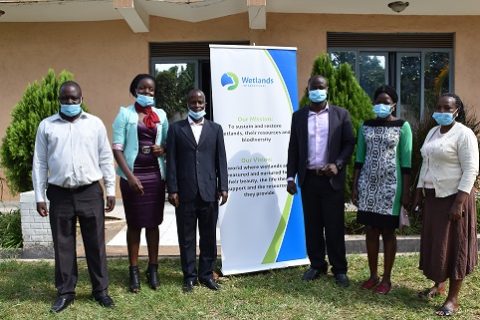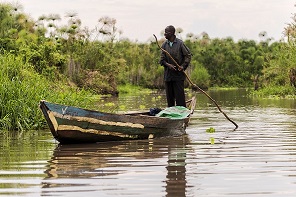Aidah Nabwire, a mother of six, has over the years watched with dread the negative effect of human activities in her home in Busia, Uganda. She is a small-scale farmer in Bumasi, one of the wards where the Sio-Siteko Wetland is located. As a little girl, this Wetland that spans Kenya and Uganda was densely vegetated. “We only harvested grass and papyrus. No one farmed in that area and it never dried. Today, there are only small pockets of grass. Trees have largely been cleared leaving the wetland open to the vagaries of the weather. During the hot season in December, it dries up, ”says Nabwire.
Nabwire is one of Sio-Siteko’s primary stakeholders’ representative who recently met with other stakeholders with the aim of constituting a Transboundary wetland management committee that will help in the implementation of the Sio-Siteko Wetland Management Plan. Facilitated by Wetlands International, the participants were drawn from both countries including community-based organisations, national and local government officials, civil society organisations and NGOs.
Sio-Siteko Transboundary Wetland Management Plan was validated in June 2020. Similar management plans have been developed for Sango Bay-Minziro in Uganda and Tanzania and Semliki in the DR Congo and Uganda. The project is commissioned by the GIZ on behalf of the Nile Basin Initiative. It is supported by the German Federal Ministry of Environment’s International Climate Initiative.
“We must move from meetings to action and tangible results. We hope that this time, working together in a participatory and open manner, we will make steps toward addressing the issues and threats on Sio-Siteko for its restoration and to boost our livelihoods,” stated Kenneth Okello a representative of the Bumasa Water Resource Users Association.

Newly formed Sio-Siteko Executive Management Committee
Located in northeast Lake Victoria and encompassing the lower catchment of River Sio, it covers an estimated area of 415 square Kilometres. It supports four million people with agriculture as the main livelihood for 85 per cent. Other forms of livelihood are sand mining, charcoal burning and harvesting construction materials. In addition to acting as a natural buffer against disasters, it is also a rich habitat for biodiversity, hosting 520 bird and 208 plant species among others. The community also has a strong attachment to the site for cultural practices.
Biting Poverty, Deficient Awareness
A few years ago, Nabwire’s lastborn son asked her why the community cultivates on the wetland. “That question gutted me. Somehow, I explained to him that the soils on the upper areas had lost their nutrients and people moved into the wetland to also boost their livelihoods. Poverty is driving many to destroy our environment! ”
Sadly, Sio Siteko Wetlands faces numerous challenges driven by a rapidly growing population, widespread poverty, weak governance systems and structures and inadequate awareness of the wetland ecosystem value by the local communities. The threats include unsustainable land-use practices, over-exploitation of wetland resources such as papyrus, wood, fish, sand and grassland, uncontrolled water abstraction, pollution, and more.

Sand harvesting near a bridge on River Sio in Busia, Kenya
Various activities and interventions were recommended for the implementation of the management plan. These would address both livelihoods and conservation under three thematic areas: ecosystem protection and restoration, livelihood improvement and institutional strengthening.
Nabwire is one of the 60 members of the Buhehe-Masinya Water Catchment and Resource Management Association that was formed in 2012 to tackle the degradation of the wetland. The Association is one of the numerous community-based organisations who are the primary users of the ecosystem. However, they still require the involvement of secondary and tertiary stakeholders such as national government institutions, local government authorities, NGOs, donor agencies, among others.
“Although we are the main users of this wetland, we still need the support – both technical and financial – from the other stakeholders to strengthen the capacity of our associations as well as facilitate and fund projects that will boost our incomes,” stresses John Wandera, Chairman of Sio-Siteko Wetland Users Associations who now doubles up as Chair of the newly formed management committee.
Early Investment Projects
In her own small way, Nabwire is planting more grass on her farm to control soil erosion, restore surface water and increase fodder. However, there is urgency for collective effort that will arrest the negative impacts on the wetland and hasten its restoration.
As part of the implementation of the management plan, Wetlands International also developed an Investment Project Plan that include short-term bankable interventions and activities that can provide quick wins for both the wetland and the community. One of the interventions include on-farm bamboo cultivation.

Beatrice Murwayi shows off a bamboo basket produced by Eco Green, a community-based organization in Busia that promotes bamboo cultivation and value addition to uplift livelihoods
“Busia County has less than two per cent forest cover. Therefore, bamboo is ideal for this area since it does very well here and has diverse uses. There is need to sensitise the youth to stop sand mining and encourage bamboo cultivation and value addition chain including marketing of products. That will be a game changer, ”stated Roselyne Barasa, Chief Officer for Water in Busia County Government in Kenya.
The success or failure in the implementation of the management plan will be determined by the level of coordination and collaboration amongst all stakeholders. Also, there is need for more deliberations on other governance structures to ensure transparency and accountability in addition to seeking support for the short-term interventions that will uplift the livelihoods of the communities as well as conserve the wetland landscape.
